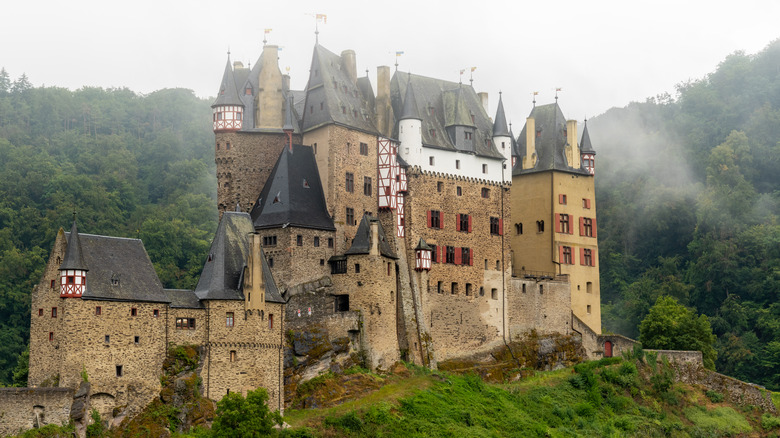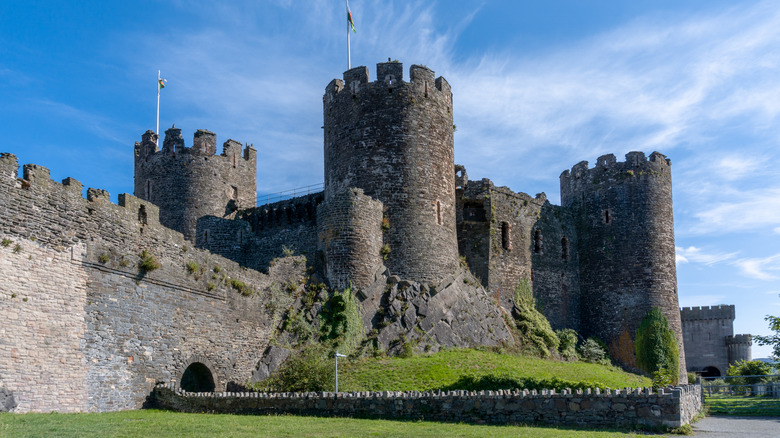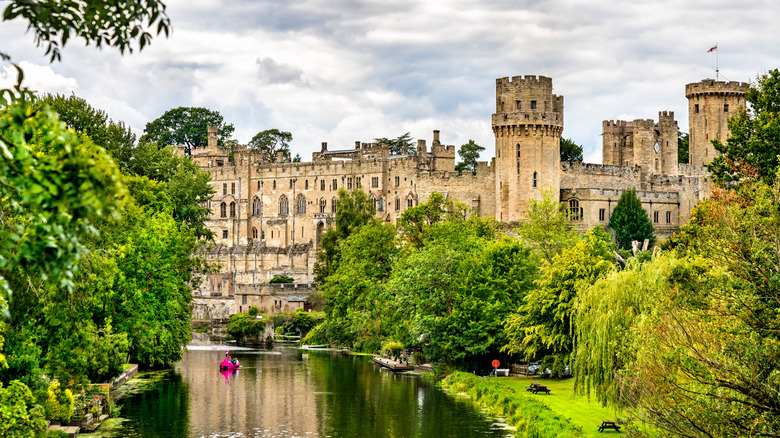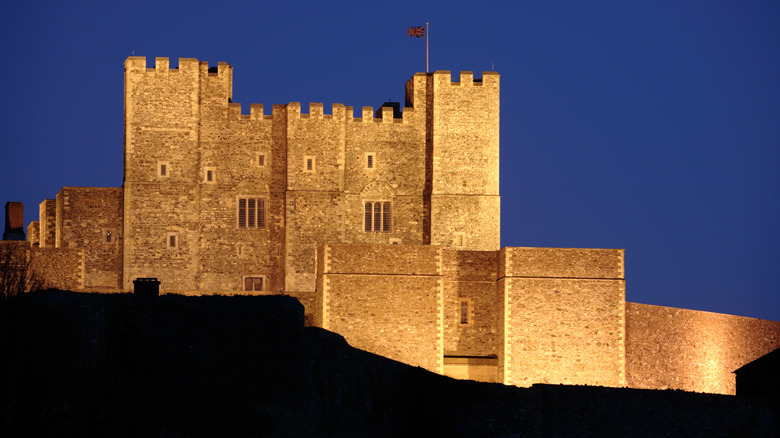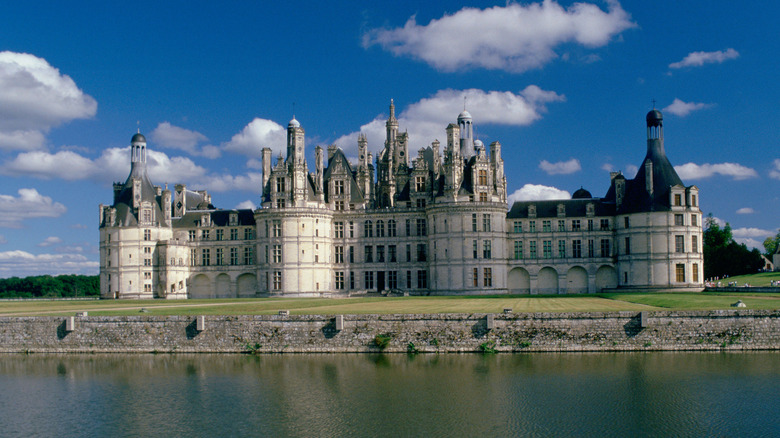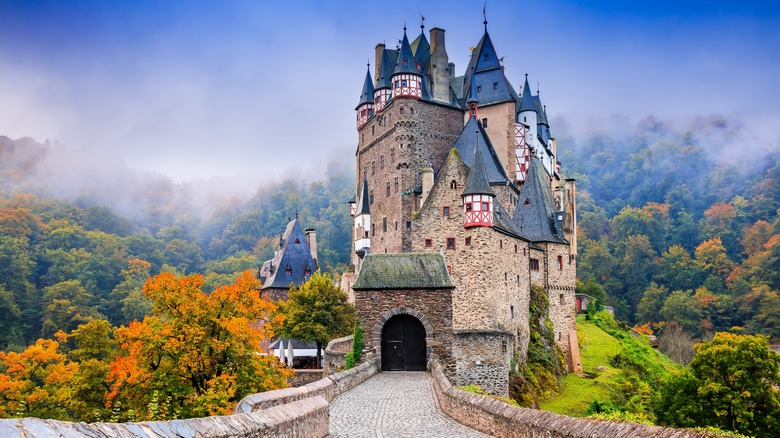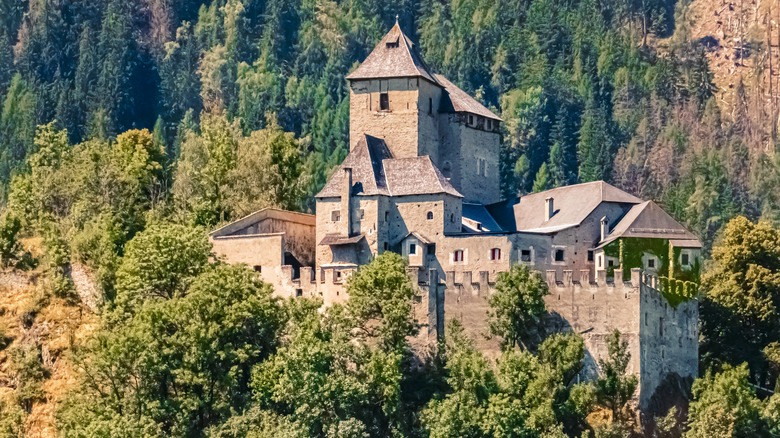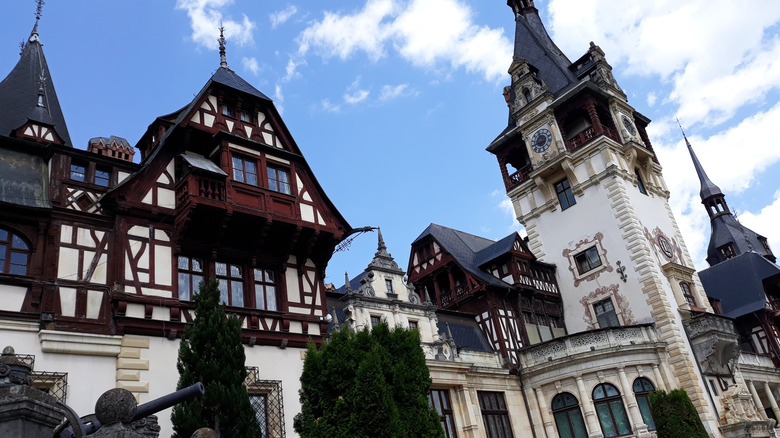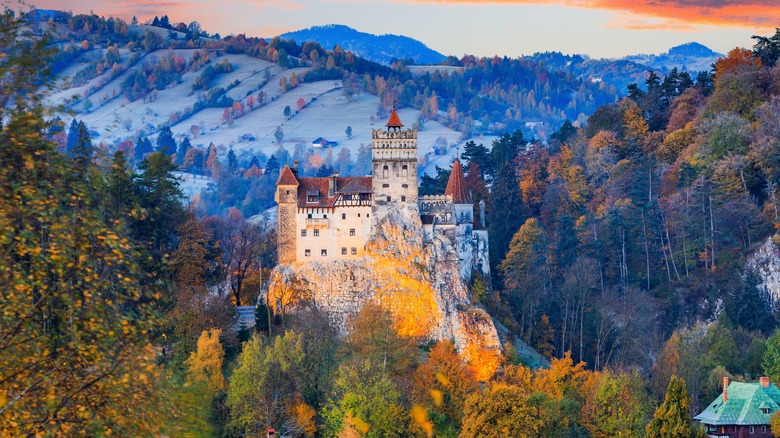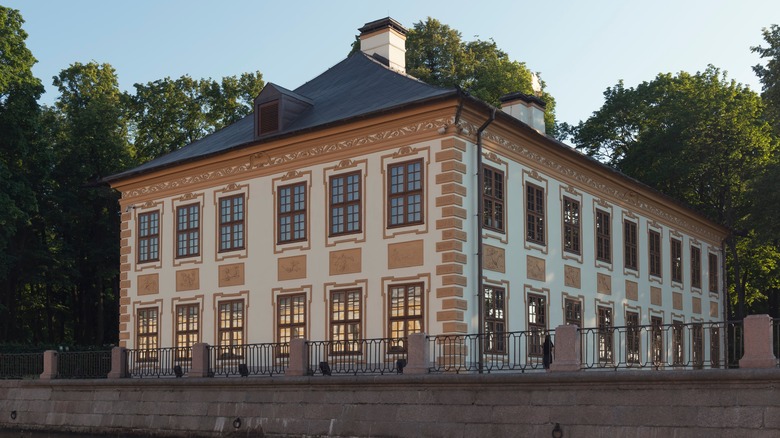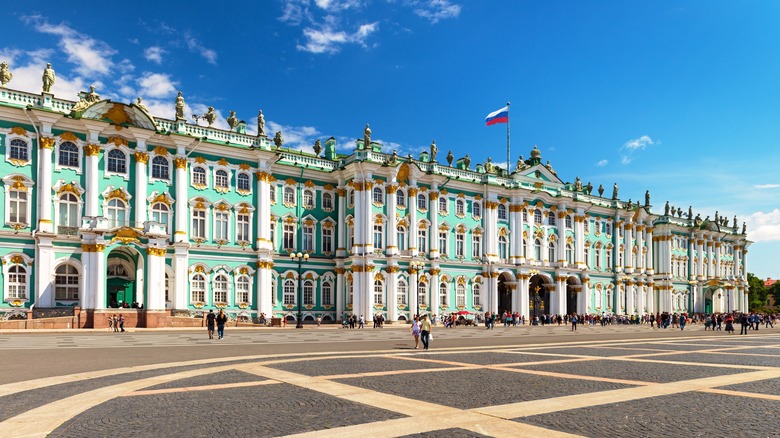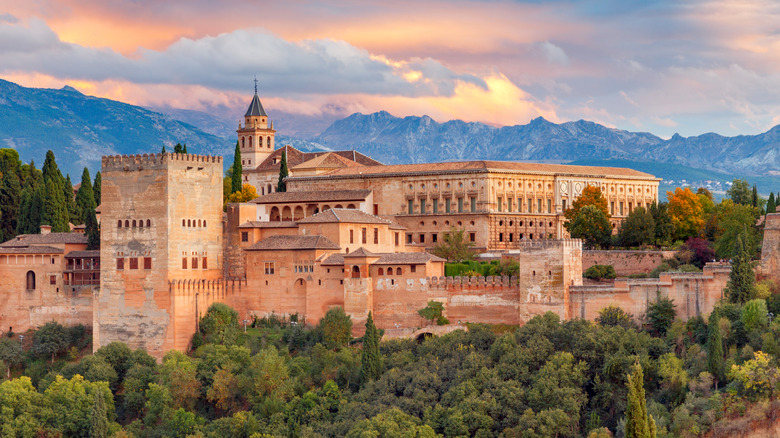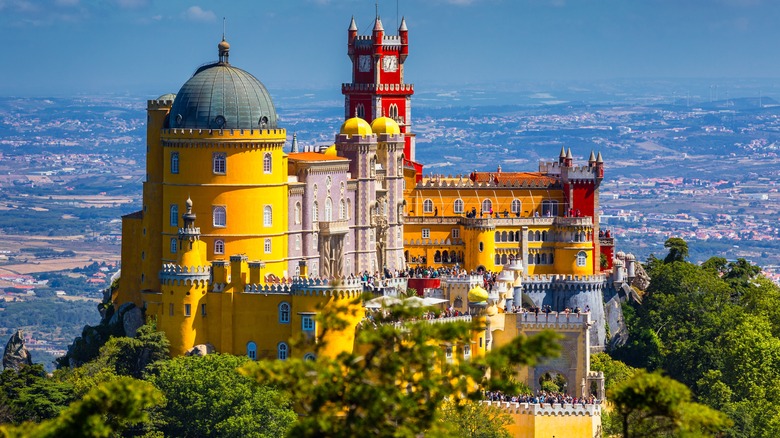Rick Steves' All-Time Favorite Castles You Can't Miss On Your Trip To Europe
Few travel experiences have the capacity to capture our imaginations like a visit to a centuries-old castle. In many ways, it's as close as someone in the modern world could come to time-traveling back to when kings ruled over their principalities and the fate of a nation was often decided at the end of a sword. It's a chance to step into a reality that seems so different from the one we live in and see how those who decided those fates, along with the hardworking folks who made their lives possible, truly lived. And the takeaway is often that, in many ways, we share more in common with these folks than we realized.
And there's something truly splendid about the grandeur of an enchanting castle with its turrets and towers. Standing before these grand halls, it's easy to see why they've inspired so many fairy tales, legends, and modern works of fantasy. It's something few understand better than esteemed travel writer Rick Steves, who has been enthralled by them for most of his life. To find out which of his favorite castles should be on our travel bucket list, we checked out the travel expert's Monday Night Travel video on "Favorite Castles and Palaces," as well as a few of his travel articles. Check out these Rick Steves-recommended castles for your next royal tour.
Conwy Castle in Conwy, Wales
A nation of more than 600 castles, Wales is a land filled with medieval wonder. And among those hundreds of ancient estates, it's not hard to see why Conwy Castle is Rick Steves' "personal favorite." A towering castle located in a walled medieval market town, Conwy is a haunting 13th-century structure that looks like something brought to life by the imagination of Edgar Allan Poe. An ancient fortification to modern eyes, Conwy Castle represented the cutting-edge of military technology when it was first built on the orders of Edward I after he conquered Wales. Located in North Wales, Conwy Castle stands high above the estuary where the river Conwy meets the Irish Sea, making it a strategic location from both a resupply and defense standpoint.
As Steves notes in "O'er the Ramparts: Castles in Great Britain," this castle serves as a reminder that despite our modern association with their grandeur, it's this military heritage for which they were originally created. With its eight looming drum towers, two baileys, east and west barbicans (a type of outpost), and the characteristic pinnacled merlons often associated with ancient castles, Steves says the castle was a "power statement from the English king to the Welsh — who had little more than bows and arrows to fight with." Solid as the rock it is built upon, Conwy stands as a living crash course in early British military history.
Warwick Castle in Warwick, England
When it comes to the most spectacular castle in England, Rick Steves says there's no better choice than Warwick. It's also one of England's oldest castles — the castle site dates back to the 11th century when the country's first Norman king, William the Conqueror, built a wooden fort just two years after the Battle of Hastings. Most of the castle that stands today was constructed between the 12th and 17th centuries, and the castle served as home to "Kingmaker" Richard Neville. Details like Warwick's curtain walls and battlements with crenulations and arrow slits serve as a reminder of just how dangerous times were in those uncertain days of the medieval war.
Writing in "O'er the Ramparts," Steves says Warwick's "lush, green, grassy moat and fairy-tale fortifications" are some of the features that make it worth visiting despite the fact that of late, the castle has evolved into something of a tourist trap. As Steves put it in Classroom Europe, "It's a hit with families — and, from dungeon to lookout, the enterprising Earl of Warwick is wringing maximum tourist dollars out of his castle." Think bird-of-prey shows, princess meet-and-greets, dungeon tours, and historical walking tours. Despite the steep price tag, Steves noted, "there's something for every taste — an educational armory, a terrible torture chamber, a queenly garden, merry bands of musical jesters, and a peacock-patrolled, picnic-perfect park."
Dover Castle in Dover, England
While Conwy Castle serves as a monument to England's early military history, Dover Castle offers a look at the region's military history dating back from the Iron Age to the 20th century while serving as a living lesson in English pragmatism and adaptability. Commenting in "Favorite Castles and Palaces," Rick Steves noted, "Dover Castle provides a quick review to England's defensive history," calling it "a many-layered complex with remnants from each age." The site is strategic as it sits on the White Cliffs above the English Channel and the North Sea at the Strait of Dover, the shortest point of crossing between Britain and the European mainland.
The castle grounds are believed to have once been home to an Iron Age hillfort predating the Roman occupation of the region. Shortly after the Romans took up residence around A.D. 43, they built a pair of lighthouses (Pharos) here, and one of them still stands today as the only one of its kind in England, as well as the country's oldest standing building. After William the Conqueror's 1066 victory, he wisely claimed the site as part of his network of fortifications. Although his original earthworks and fortifications were destroyed, the strategic site would be rebuilt and expanded upon during the 12th century by Henry II. During the 20th century, it proved integral to the war effort during both World Wars.
Château de Chambord in Loire Valley, France
One of the hundreds of Loire châteaux — stunning must-see estates built in the valley adjacent to France's last major free-flowing river, the Loire — Chambord is the "granddaddy" of them all, Steves said in "Favorite Castles." A breathtaking 16th-century French château built by Renaissance man Francis I beginning in 1519, Chambord was inspired by the French King's admiration for Italian Renaissance architecture, particularly the work of Leonardo da Vinci. The master's influence can be seen in features like the château's ventilation system, keep design, and spiral double helix staircase. The palace's construction would continue for the better part of two centuries, finally drawing to completion under the Sun King Louis XIV in 1670.
The magnificent, palatial estate is a Disney fantasy on steroids, featuring dozens of staircases, 440 rooms, and 365 fireplaces spread over a sprawling 200,000 square feet. While it's clearly designed to impress, Chambord features a formidable defense system, including a quartet of medieval corner towers, a traditional moat, and a 20-mile-long enclosure. Inside this wall is a gaming preserve that serves as Europe's largest enclosed forest, where royal hunting parties once hunted wild boar and deer. The facade's generous showing of medallions, ornamentations, chimney stacks, gables, and various Gothic details add to its overall decadence, making it what Steves called a "secular rival to the Vatican."
Eltz Castle in Wierschem, Germany
Rick Steves' favorite German castle, the travel expert described Burg Eltz as a "mystical castle standing tall in a haunted forest" in his "Favorite Castles and Palaces." A beautifully preserved example of a medieval castle, Burg Eltz sits on a 229-foot oval rock spur nestled deep in the heart of a lush green valley above the Moselle River. Its steep towers, height, and moat helped ensure the castle's survival through centuries of warfare, making it virtually catapult-proof.
The estate has been owned by members of the Eltz family dating back to the mid-12th century. The charming storybook castle as it exists on the site today dates back five centuries and was originally built along a critical trade route. One of the things that makes this castle so unique is its representation of different types of architecture as a living record of the family's history. Construction of the medieval and Renaissance-era castle began in the 12th century but would continue for generations. As construction on the main structure took place over hundreds of years, it incorporates Baroque and Romanesque styles. As Steves cheerfully recounted in "Favorite Castles and Palaces," the family still enjoys sharing their ancestral home today, even placing flowers in every room to brighten things up for guests.
Reifenstein Castle in Freienfeld, Italy
Like Burg Eltz, Reifenstein Castle once formed a strategic stop on an essential German trade route that ran all the way down to Italy. And much like the Eltz ancestral home, Reifenstein has been owned by the same nobles for generations. The stone castle sits on a rocky hill in Tyrol, an alpine region spanning Germany, Austria, and Italy. The grounds have been home to a castle for a millennium, with the structure that stands there today dating back five centuries.
As Steves explained in Classroom Europe, this stunning castle is one of the best ways to peer into the world of German castle life during the Middle Ages. Praising the castle's interior, Steves highlighted its "hefty timbers," calling the woodwork "artful." But it's some of Reifenstein's engineering details that Steves says make the castle such a splendid example of medieval castle life, from its cistern to the "clever funnels" developed to help guide door keys into their keyholes. The castle also contains a rare surviving example of an original secular medieval fresco painted during the 15th century.
Peles Castle near Sinaia, Romania
Peleș Castle is another fantastic example of a German castle not located in present-day Germany. Peleș is situated in the Carpathian Mountains along a medieval trade route but was actually built in the late 19th century by the German-born Carol I, who served as Romania's first king. A more modern palace of Neo-Medieval design evoking Italian and German Renaissance styles, Peleș was commissioned by the Romanian king to serve as a hunting retreat.
As a modern castle, Peleș was unique in that it came kitted out with all of the modern amenities like electricity and central heating. In "Favorite Castles and Palaces," Steves described the Romantic-era palace as a "fanciful hunting lodge" with "over-the-top spires" meant to evoke the architecture of King Carol's German homeland. Although its exterior seems like it was taken from a children's fable, Steves noted that Peleș's interior boasts a "dazzling" look at the grandeur of the Romantic age. A stroll through its halls, he added, will reveal the decadence of the age through the castle's "exquisite" woodwork, a bibliophile's dream of a library, brilliant red carpets, extensive armor and weaponry collections, a grand staircase, a Hall of Honor, and "glittering crystal chandeliers."
Bran Castle in Transylvania
Just a short drive from Peleș Castle through the Carpathian Mountains is none other than Dracula's castle — that is, according to modern legend. The reality is that although a description of the castle is said to have inspired Bram Stoker's gothic horror, it has very little else to do with the fictional bloodsucker. But it's still quite possibly one of the world's most haunted places, as the locals are happy to capitalize on the legend with everything from vampire-themed merch to an annual Dracula ball and academic monster symposia.
According to Steves, the region is known for its wild countryside, which in part led to the castle's creation. During the 12th century, the region's Hungarian rulers brought skilled Germanic Saxon workers into the community who immigrated under special royal privilege. This led to the development of German enclaves in Transylvania. Although a wood castle had been built at the site during the early 13th century, the Transylvania Saxons were permitted to build a fortification to protect their community in 1377. "Despite the fanciful legends," Steves emphasized in "Favorite Castles and Palaces," "Bran is actually a fine example of an authentic medieval fortress dating from the 14th century." The nearby community is as close to a medieval German town as you'll likely find outside Germany.
The Summer Palace of Peter the Great in St. Petersburg, Russia
Modern man that he was, Russian Tsar Peter the Great was greatly taken with other Enlightenment-era European parks and wanted to create his own take on the hot trend. Enlisting Domenico Trezzini, the Italian-Swiss architect who helped pioneer the Russian architectural style known as Petrine Baroque, he set out to create the Summer Garden and Palace as the ultimate 18th-century party destination. Much like Marie Antoinette's rustic model farm, it also afforded the tsar an escape from full-blown palace life.
Located a short distance down the Neva River from the tsar's Winter Palace, the Summer Palace was sort of a mini-palace with just seven rooms on each of its two floors. What makes this castle so remarkable to visit is the painstaking detail with which the 18th-century interior has been recreated, giving a real sense of what it was like to visit there during its heyday. Outside, guests can stroll through the gardens, where they'll find marble statues, a serene pond, and even a pair of swans. For Rick Steves, the small palace is a beautiful example of the Russian baroque style shining through. "It really is a sumptuous look at the luxurious elitism of the tsars that really brought on the Communist revolution," Steves observed in "Favorite Castles and Palaces."
Winter Palace in St. Petersburg
Like the Summer Palace, the Winter Palace was once an extravagant Baroque residence for the Russian royal family. The Winter Palace was designed by Bartolomeo Francesco Rastrelli, the French-born son of an Italian sculptor and architect. Rastrelli designed the palace in the deliciously over-the-top Elizabethan Baroque or Rococo style that Rick Steves calls "a little bit like Soviet kitsch" in "Favorite Castles and Palaces." Steves added, "In some ways where they have gilded everything, it's just drenched in extravagance."
Catherine the Great would later redesign the palace's interior in the Neoclassical style, but Rastrelli would roll back some of her changes after a fire. With its green and white exterior and gold details, it's a splendid example of the decadence of this point in European history. Today, the more than 645,000-square-foot estate has been converted into the State Heritage Museum, where visitors from all over the world can marvel at its opulence while taking in the museum's extensive art collection.
Alhambra Palace in Andalusia, Spain
Describing Spain's Alhambra Palace in "Favorite Castles and Palaces," Steves noted that the palace is a Moorish castle. "The capital of the Moors for centuries in the south of Spain," Steves explained, "The sounds, sights, and experiences of southern Spain are shaped by waves of history." Like many medieval castles, Alhambra served as a royal residence and fortress for the ruling emirs from the 13th through 14th centuries. A multi-structure estate, the palace is considered by many to be one of the finest examples of Moorish architecture still in existence today.
Situated near medieval Granada's Arabic quarter, the palace is particularly notable for the hydraulic engineering behind the irrigation system that made its elaborate gardens and urban agriculture possible, a marvel of medieval infrastructure. The grounds are entered by two main gates: the Puerta de la Justicia, meaning Gate of Justice, and Puerta de las Armas, meaning Gate of Arms. Another remarkable feature of this enchanted palace is its ornate Arabic epigraphy with calligraphic writing and art. Gorgeous mosaic tilework, brilliantly painted ceilings, and ornate carved stucco and wood add to the sense of grandeur courtesy of the Nasrid dynasty. Its red hue comes from the clay the fortress is made from.
Pena Palace in Sintra, Portugal
Built of the same age and spirit as Romania's Peleș Castle, Pena Palace is a colorful Romantic castle located on the Portuguese Riviera. A short distance from Portugal's Castle of the Moors, Pena Palace sits above the town of Sintra at the top of a hill. The land the castle is built on was home to a religious site for centuries until the monastery that once stood there was knocked down by a 1755 earthquake.
During the 19th century, it was acquired by Ferdinand of Saxe-Coburg and Gotha, who was said to be a rather cultured and cosmopolitan man with a reputation as a prodigious artist. Living up to his name, Ferdinand directed the creation of the elaborate and fantastical estate. Intermixing Moorish Arabic influences, medieval Christian features, and an overall sense of fantasy and exoticism, the King-consort would create an eclectic marvel like nothing ever before seen. Reflecting on the Romantic era in "Favorite Castles and Palaces," Steves described Pena palace and others of the era as "fanciful dreamscape castles" made by a "star-crossed, two-bit ruler."
